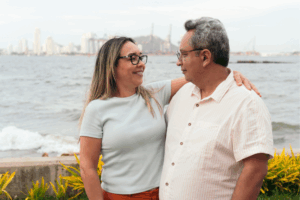When I was in high school, there was a sign at the end of the locker room, which we’d see as we were running out of the building toward the football field: “Pain Is Temporary. Pride Is Forever.” It’s one of those dumb and inspiring things you believe at 15, and it seemed true. Even when you were in pain from a big hit, your coaches and teammates would remind you that “you’re not in pain” and to “suck it up!” Pain was subjective, invisible to everyone but the sufferer, and somehow seemingly shameful. As the years went by, the pride that came from beating our rivals faded, but pain—both its presence, and the idea that it was both private and a sign of weakness—persisted.
Too often, this idea endures even in our aging loved ones. No one can actually feel their pain, and too often, chronic geriatric pain goes unreported, as people feel that hurting is just a normal part of aging. While that is partly true, chronic pain is not normal, and the more people know about it, the more comfortable they’ll feel talking about it, having it assessed, and ultimately treated.
The Physical and Mental Dangers of Living With Chronic Geriatric Pain
Everyone has aches and pains as they get older; the human body is imperfectly designed for the specific stresses we put on it. As people age, they may wake up with creaking joints, and as muscular and skeletal structures weaken, smaller bumps that might have been brushed off now hurt more than before. That’s all normal.
What isn’t normal, or at least what isn’t an inevitable and acceptable part of aging, is chronic pain. Chronic geriatric pain is defined as “an unpleasant sensory and emotional experience associated with actual or potential tissue damage, or described in terms of such damage, for persons who are either aged (65 to 79 years old) or very aged (80 and over) and who have had pain for greater than 3 months.”
This is the sort of pain, often associated with persistent inflammation of the musculoskeletal systems (though with many other causes, including sickness), that can change a life. It’s pain that alters your outlook, as the pain becomes the main focal point of life. It isn’t even just the sensation itself; it is the understandable thought that the pain will never go away.
This can easily lead to depression, social isolation, constant anxiety, cognitive impairments (as focusing on the pain seems like the only thing that’s real) and trouble sleeping, which exacerbates everything else. In some cases it can lead to a wish for life to end, and action to meet that wish. These are cases where psychological services are needed, of course, but treatment starts before that. It starts with the recognition that this pain isn’t a normal part of aging. When chronic pain is a part of life, there are treatment options.
Assessment and Treatment
This process should begin with an assessment. Because pain is subjective, these assessments are based largely on communication. One reason many people are afraid to report pain is because they are worried that it is a signifier of something worse, a sickness like cancer. That’s all the more reason to report it.
As a caregiver, you have to encourage your aging loved one to be extremely honest during the assessment, so that the doctors can work to understand the cause of the pain. If memory is an issue, you may need to help fill in the gaps. Remember, the only way to help is for the doctor to know exactly what is going on. The full assessment will likely include a physical component as well—a battery of tests that evaluate things as diverse as flexibility, movement, and muscular defects. A good test will also try to isolate unintentional inconsistencies. Pain can cloud judgment, and so having a full and complete picture is the only way to make sure that treatment is correct.
From here, a plan will be instituted to manage and reduce pain. If the pain is severe, it will have to be dealt with by pharmacology before anything else can happen; however, many doctors wish to avoid relying on medicine as much as possible. If the pain is caused by a genuine illness, of course, treating that is the main source of pain alleviation. Even then, though, during treatment, there are ways to manage pain, and they are the same if pain comes from another source.
- Exercise. Keeping muscles moving and in good health can reduce the incidence of pain. This includes strength, condition, and flexibility.
- Diet. The right diet can increase digestive health which has a huge impact on overall well-being, and can strengthen the rest of the body.
- Proper sleep. It may seem like a Catch-22, as sleep is very difficult with pain, but getting proper and consistent sleep allows the body to heal and to deal with nagging issues that can become big concerns.
- Technological aids. We live in an on-demand world. There are apps for older adults that can get groceries, order food, have their medicine delivered, and have cars come pick them up. This not only facilitates aging in place, but it reduces normal wear and tear.
Pain is not always temporary, and the idea that it is shameful is a persistent and debilitating myth. Pain is a signal that something is wrong, but it is more than that: it’s a menace to quality of life, an intruder that takes up space in your body, mind, and spirit. Chronic geriatric pain doesn’t have to be forever. Treatment is possible, as long as all parties are honest, open, and willing to work to reduce it. That is the kind of pride that can last forever.
The aging process is different for everyone, and at the Institute on Aging, we know that living in pain doesn’t have to be a part of it. We work to educate families, caretakers, and older adults on the smartest and healthiest ways to age at home. Connect with us today to learn more.







